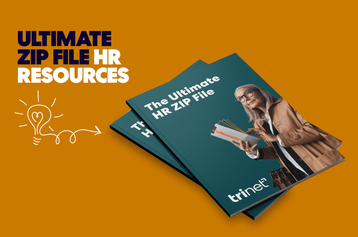HRIS Trends That Are Shaping the Business World

Table of contents
- 1.HRIS Trends
- 2.AI-driven HRIS
- 3.Using generative AI
- 4.Mobile-first HRIS
- 5.Making HRIS more user friendly
- 6.Increasing use of HR data
- 7.Automation to help with compliance concerns
- 8.Using exposed API connections
- 9.LCNC platforms (Low-Code/No-Code)
- 10.Integration and expansion beyond HRIS
- 11.A power, versatile HRIS
For most businesses to succeed, grow and profit, they need to maintain an effective HR department. For small businesses, that department may have only one or two employees. For the larger companies, HR departments can well exceed 5,000 employees.
But make no mistake. Whether for a small or large workforce, it's a constant grind for HR professionals to oversee important HR processes. Major HR functions must be carried out daily — payroll processing, onboarding, offboarding, benefits administration — or employees may seek employment elsewhere.
That's why businesses are turning to HR technology solutions to streamline their HR processes. The human resource management market is projected to reach $56 billion by 2030, growing 12.7% annually from 2023 to 2030. Digitization of data analytics, mobile HR apps, cloud-based platforms, and automation are powering the growth, increasing efficiency and expanding capabilities.
It's an exciting time for HR tech. So, let's look at some of the strategic HR solutions and trends that are driving HR's digital transformation.
HRIS Trends
HRIS is, by definition, a technology function — therefore it tends to advance in step with other new technology developments. Businesses exploring HR solutions can benefit from understanding the different types of HRIS systems and what they offer. Here we'll review some HR trends and see what the latest technology is all about.
1. AI-driven HRIS
Aside from the often-dramatic portrayals of Artificial Intelligence (AI), it's becoming a useful and major tool to help streamline HR operations. Automation is one facet where AI shines, with the proper care. As AI becomes better at labor-heavy tasks (like payroll processing and HR data entry) its usefulness will only increase.
AI chatbots can help provide employees with information and deliver data to HR teams. With proper setup and use, AI may be able to help parse potential employee's resumes for relevant education and experience — though human oversight is still needed. HR tech trends will continue to include AI innovation and businesses will reap the benefits.
2. Using generative AI
Generative AI tools like ChatGPT are still evolving — but they may eventually provide many helpful tools. They may be able to help with:
- Writing first drafts of job descriptions
- Creating copy for recruitment marketing
- Offering interview questions based on expected knowledge
- Writing forms, letters, and emails
- You can even ask them to help you write AI search queries
In the long run, generative AI is expected to improve and even more useful to HR departments. This, with appropriate controls in place, will increase effectiveness and help reduce labor loads.
3. Mobile-first HRIS
Mobile-first means a software is primarily designed for mobile devices. This trend is driven by an increasing number of users preferring to access HR systems on their smartphones or tablets. It allows employees to handle routine HR tasks (time-off requests, benefits enrollment, performance reviews) from anywhere.
Going forward, mobile-first designs will increase to support our increasing use and reliance on mobile devices. Not only for employees, but for HR staff as well. Everyone can access HRIS features on mobile devices, anytime and anywhere, through optimized interfaces and dedicated apps. Employees on the go can record time worked, make time off requests, sign off on documents, and handle other human resources tasks. HR professionals also benefit from the easy access when traveling, working remotely, or dealing with on-location or out-of-office HR needs.
4. Making HRIS more user friendly
A user-friendly HRIS is convenient, accessible, and easy for employees and HR staff to navigate. This is no longer a luxury, and HRIS providers are working to improve user interface (UI) and user experience (UX). Clear, intuitive designs and features are emphasized, so users can effectively operate the system with minimal training.
Less time spent on group onboarding sessions or having to schedule time to watch videos in a conference room. Accessible and intuitive employee interfaces bring all that into a simple, easy-to-use HR software suite. All employees — no matter their level or role — benefit from the advances.
And when HRIS is more user friendly, employees are more likely to perform HR tasks promptly. It's generally easier for IT departments as well, because there may be fewer calls to tech support. That not only speeds HR functions, but also frees up IT to perform other tasks. This win-win scenario is just one example of why user-friendliness is becoming part of other strategic HR initiatives.
5. Increasing use of HR data
Predictive data analytics has also become a major HRIS feature. Unlike the average person, machine-learning AI doesn't mind sifting through tens of thousands of HR data records to find useful patterns. Data analysis can be used for several things:
- Suggest the best use for team members’ assignments, based on past successes and failures
- Discover which company initiatives produce useful results and are most effective
- Help predict whether an employee is thinking about leaving, perhaps with 95% accuracy
- Create reports based on employee trends involving sick leave, vacation, personal leave, work injuries.
As the future brings more integration of company systems, HRIS will have access to more data. With more data at its digital fingertips, AI-powered HR analytics help find additional patterns and offer better analysis and solutions.
6. Automation to help with compliance concerns
HR policies require organizations to comply with HR rules and requirements, which is complex and requires continuous attention. This drives the automation of certain features in HRIS. Those features may include monitoring for employment-related rules and requirements, data privacy concerns, and maintaining audit trails.
HRIS can help solve many concerns through automation and streamlining of HR processes and document management. Automatic alerts can be sent to admin staff to remind them of upcoming audits, updates, and deadlines. Likewise, automated messages can be sent to employees to remind them to review and update their information. Furthermore, HRIS provides other employee self-service resources: FAQs, learning and development training, knowledge bases, and HR best practices. The list grows every day.
7. Using exposed API connections
Exposed Application Programming Interface (API) in HRIS allows third-party applications to integrate with HRIS platforms. This provides flexibility to organizations that need to customize their platforms. These interconnected APIs allow businesses to add new features or connect to other internal or external systems to streamline operations.
API availability has greatly boosted modern HR software development. Going forward, HR departments may look for an increase of API use to integrate disparate systems, which will let other standalone apps exchange and sync information together. For example, a recruitment platform uses an API to sync information about the candidate to the background check vendor to run background checks on prospective employees. As more and more systems are interconnected, efficiency may rise even more.
8. LCNC platforms (Low-Code/No-Code)
LCNC platforms enable the development and deployment of application software with minimal coding by hand. This lets non-technical individuals create applications, helping to reduce dependence on professional developers. This trend allows users to create or customize their own HR software solutions based on each unique requirement.
LCNC is enabling HR departments to save development time and costs. Clunky, hard-to-navigate spreadsheets can morph into efficient workflows. LCNC will continue to help HR departments to easily create surveys, analytic dashboards, hiring apps and other tools.
9. Integration and expansion beyond HRIS
The market is seeing more HRIS integration with other enterprise systems, such as Payroll, Accounting, Enterprise Resource Planning (ERP), and Project Management. Platforms will continue to expand far beyond key HR processes such as on-boarding, learning management, employee engagement, and performance tracking. HR service delivery solutions will likely evolve into an all-in-one platform for employee lifecycle management.
Previously, HRIS systems were operated separately from other company software packages. This may have arisen from beliefs that employee analytics had limited impact on revenue and provided limited business intel. But that's changing. HR metrics on hirings, tenured vs. new staff ratios, and other KPIs have become vital to company planning. As we mentioned earlier, some new systems can predict, with high accuracy, when an employee may consider leaving. Breakthroughs in strategic HR will continue as databases are cross-linked and automatically analyzed by AI platforms.
In the future, HRIS platforms will become even more vital to businesses. There are benefits coming from platform integration and expansion that is done with data security in mind, and it is expected that organizations will incorporate their HR information systems into broader company infrastructures.
A power, versatile HRIS
As a professional employer organization (PEO), TriNet can help you do more meaningful work — and less HR admin — with a comprehensive HR outsourcing solution including access to benefits, payroll processing and risk mitigation that’s powered by expert support and leading technology.
Or, if you want to run HR in-house with an intuitive, cloud-based platform, we've got you covered. Our powerful HRIS lets you choose from a variety of options so you can add tools such as recruiting software, 401(k) provider, outsourced services and more. Would you like to save time onboarding new hires, HR administration, and potentially save on payroll processing and benefits administration? Contact TriNet today to get help.
This communication is for informational purposes only, is not legal, tax or accounting advice, and is not an offer to sell, buy or procure insurance.
This article may contain hyperlinks to websites operated by parties other than TriNet. Such hyperlinks are provided for reference only. TriNet does not control such web sites and is not responsible for their content. Inclusion of such hyperlinks on TriNet.com does not necessarily imply any endorsement of the material on such websites or association with their operators.

TriNet Team
Table of contents
- 1.HRIS Trends
- 2.AI-driven HRIS
- 3.Using generative AI
- 4.Mobile-first HRIS
- 5.Making HRIS more user friendly
- 6.Increasing use of HR data
- 7.Automation to help with compliance concerns
- 8.Using exposed API connections
- 9.LCNC platforms (Low-Code/No-Code)
- 10.Integration and expansion beyond HRIS
- 11.A power, versatile HRIS










